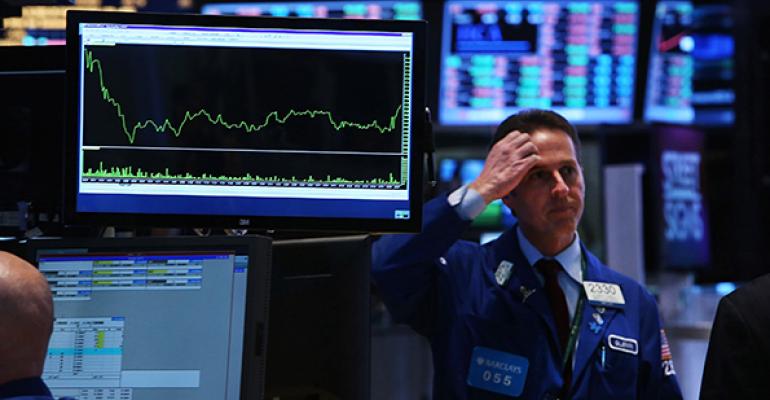By Barry Ritholtz
(Bloomberg View) --This week marks the 42nd anniversary of the founding of Vanguard Group Inc. by Jack Bogle in 1975. That date made me think about Bogle’s recent advice for active managers. At the 2017 Morningstar Investment Conference in Chicago last week, Bogle said:
Do nothing, just stand there . . . Maintain your fund business as the ‘cash cow’ that it is today, delivering high margins and generous profits, albeit likely at a declining rate. Don’t invest more capital. Don’t cut management fees. Nominal cuts won’t help, and severe cuts would eliminate those cash flows. While fund cash outflows are highly likely to continue, a sharply rising stock market, however unlikely, would help offset the outflows, slowing the declines in assets under management, fee revenues and profits.
This would be terrible advice, assuming Bogle was being serious -- which he wasn't. However, his sarcasm does raise a question worth exploring: What should active mutual-fund companies do in response to the current outflows from them and into low-cost indexing and exchange-traded funds?
I have a few ideas.
First, my usual disclosure: I run an asset-allocation portfolio that is low-cost, global and made up of mostly passive indexes and other strategies; I also run a tactical portfolio that serves behavioral purposes. Regular readers know I have been critical of high-cost investment vehicles that fail to deliver on their promises, be they hedge funds, venture capital or actively traded funds. Thus, my preferences and biases should be well understood by readers.
With that said, let's consider a few suggestions for the active manager who is fretting over the state of their industry:
No. 1. Become more efficient and less expensive: The Vanguard Effect dictates relentless cost-cutting by fund managers in order to stay competitive. Too many active mutual-fund managers, of course, have tried to ignore this message. But you can't overlook the fact that Vanguard Group has more than $1 trillion in active portfolios; the managers there would tell you that costs matter more than the level of trading activity. If you want to be active, you must also be ruthlessly efficient and drive costs down in the same manner as Vanguard.
No. 2. Innovate and add value: Most active mutual-fund managers are focused only on performance. But data shows “that the vast majority of active managers are unable to produce excess returns that cover their costs.” Instead, consider impact investing or smart beta -- something other than selling the possibility that your fund is the lottery ticket that can consistently beat the market over time.
No. 3. Communicate your core philosophy better: Here's a question: What exactly do you do best? What is your core philosophy? Figure out what your special purpose is, and find a way to explain this to your investors (and potential investors) in a compelling and interesting fashion. Failing to do this will simply lead to more and more outflows.
No. 4. How do you fit into an investor’s portfolio?: Here is an overlooked reality: You are not capturing 100 percent of your investors’ holdings. They likely have many other holdings, each of which serves a different purpose. Recognizing how you fit into the mix is much smarter than assuming your fund makes up their entire portfolio.
No. 5. Stop blaming indexing or ETFs for your woes: Active managers have taken to blaming passive investing for all manner of their own failings. Some have called passive investing “worse than communism”; others have said they are financial WMDs. This is a pointless exercise.
Investors have figured out they were paying too much and getting too little. Understanding that is the first step toward dealing with it.
No. 6. Bonus idea -- be patient: Keep in mind that this too shall pass. Not the move towards indexing; that’s a permanent shift in the investing landscape. But what will change is the huge, one-directional flows. There will be an equilibrium somewhere in the future.
Today, the markets are placid, low-volatility affairs that have gained fairly steadily since the end of the financial crisis in March 2009. At some point, that will end. Markets will again become volatile, and experience vicious selloffs and snapback rallies. Many of those folks who embraced passive investing will realize it’s much harder to keep emotions out of the picture than they expected. Rather than ride it out, they will seek some sort of sanctuary, and that will create opportunities for some active managers.
Over the decades, active mutual funds have gotten fat on big fees, investor ignorance and a rising market that let people overlook the costs. That era is over. The sooner active managers figure out how to best serve investors, the sooner they will begin to thrive again.
This column does not necessarily reflect the opinion of the editorial board or Bloomberg LP and its owners.
Barry Ritholtz is a Bloomberg View columnist. He founded Ritholtz Wealth Management and was chief executive and director of equity research at FusionIQ, a quantitative research firm. He blogs at the Big Picture and is the author of “Bailout Nation: How Greed and Easy Money Corrupted Wall Street and Shook the World Economy.”
To contact the author of this story: Barry Ritholtz at [email protected] To contact the editor responsible for this story: James Greiff at [email protected]
For more columns from Bloomberg View, visit bloomberg.com/view





